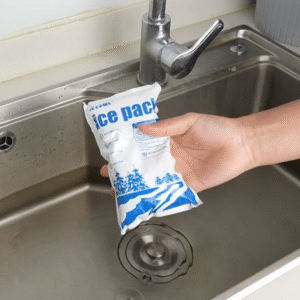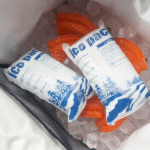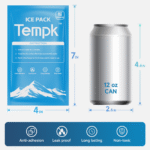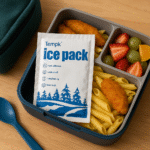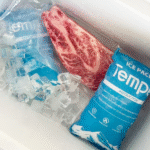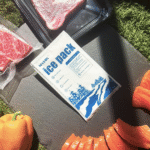How Do Packaging Supplies Dry Ice Pack Sheets Improve Cold Chain Logistics in 2025?
Packaging supplies and dry ice pack sheets are revolutionizing cold chain logistics. Packaging supplies dry ice pack sheet technology combines advanced materials with phase‑change cooling to maintain temperatures between –20 °C and –70 °C. Im Gegensatz zu herkömmlichem Trockeneis, these sheets flex like thermal batteries and activate immediately when exposed to ambient air, providing consistent cold for up to 72 Std.. By pairing them with insulated containers, vented packaging and sustainable materials, businesses can cut product loss, simplify compliance and enhance sustainability in 2025. In diesem umfassenden Leitfaden, you’ll learn how these supplies work, Warum sie wichtig sind, how to implement them and what trends will shape your cold chain strategy.
-
What are packaging supplies dry ice pack sheets? — understanding the technology and its advantages using long‑tail keywords like ultra‑cold pack sheets Und next day dry ice sheet safety.
-
How do packaging supplies enhance cold chain logistics? — exploring insulated containers, vented packaging and sealable bags that prevent premature sublimation.
-
How to implement dry ice pack sheets effectively? — step‑by‑step guidance on activation, Platzierung, monitoring and cost analysis.
-
What sustainability efforts are underway? — insights into renewable CO₂ sources and eco‑friendly packaging materials.
-
What are the latest 2025 cold chain trends? — innovations such as smart monitoring systems, hybrid cooling and automation.
-
Frequently asked questions and actionable recommendations — clear answers to common queries about duration, Wiederverwendung, safety and disposal of dry ice pack sheets.
What Are Packaging Supplies Dry Ice Pack Sheets and Why Do They Matter?
Direct Answer and Key Benefits
Packaging supplies dry ice pack sheets are flexible thermal devices made with phase‑change materials (PCMs) that maintain ultra‑low temperatures between –20 °C and –70 °C for 24–72 hours, offering safer handling and easier logistics compared to traditional dry ice. These sheets activate when flexed, releasing cold energy and maintaining uniform temperatures without the sublimation issues of solid CO₂. Because they are classified as non‑hazardous, they simplify regulatory compliance and reduce the need for hazardous material training.
Erweiterte Erklärung
Dry ice pack sheets function like mini cold batteries. Each sheet contains proprietary PCMs that absorb heat as they shift from solid to liquid. The freezing points are calibrated to achieve specific ultra‑cold temperatures, and multilayer insulation slows heat transfertempcontrolpack.com. When flexed before use, the internal structure initiates the cooling reaction, ensuring immediate performancetempcontrolpack.com. Unlike traditional dry ice that sublimates at –78.5 °C, producing CO₂ gas and requiring vented containers, these sheets maintain targeted temperature ranges without emitting hazardous gastempcontrolpack.com. This non‑hazardous classification means shipments need less documentation and handling restrictions, making them ideal for overnight shipments, emergency deliveries and cross‑border logisticstempcontrolpack.com.
Packaging supplies complement these sheets by providing the right environment for optimal performance. Isolierte Behälter, vented packaging and sealable bags ensure controlled heat transfer and safe dissipation of any gasestempcontrolpack.com. When combined, these components create a robust system that protects perishable goods, pharmaceuticals and biological samples during transit.
The Technology and Performance Behind Dry Ice Pack Sheets
The innovation behind next‑day dry ice pack sheets lies in the precise formulation of their PCMs and the construction of the sheet. Each sheet contains non‑toxic, industrial‑grade materials that remain stable at sub‑zero temperaturestempcontrolpack.com. The multilayer design includes insulating barriers and moisture barriers that slow external heat influxtempcontrolpack.com. These features allow consistent thermal performance across varying ambient conditions, making them suitable for emergency shipments and last‑mile delivery.
| Performance Aspect | Traditionelles Trockeneis | Next‑Day Dry Ice Pack Sheets | Real‑World Impact |
|---|---|---|---|
| Temperaturbereich | –78,5 °C; risk of over‑freezing | –20 °C to –70 °Ctempcontrolpack.com | Maintains goods within specific ultra‑cold ranges without freezing adjacent items |
| Handling Safety | Requires specialized gloves and ventilation | Standard handling protocolstempcontrolpack.com | Reduces staff training and injury risk |
| Dauer | 24–48 Stunden | 24–72 Stundentempcontrolpack.com | Longer protection accommodates delays |
| Regulatory Classification | Hazardous; Und 1845 Kennzeichnung erforderlich | Nicht zusammenhängendtempcontrolpack.com | Simplifies shipping documentation and reduces fees |
Practical Usage Tips and Advice
- - Activate properly: Flex the sheet gently before placement to initiate the cooling reaction and ensure uniform cold distributiontempcontrolpack.com.
- - Pair with insulated containers: Use high‑quality insulated boxes or coolers to slow heat gain; this can extend performance by up to 40%tempcontrolpack.com.
- - Plan for extreme conditions: In very warm environments, consider combining sheets with additional insulation or hybrid systems (Trockeneis + PCMs) stabile Temperaturen aufrechtzuerhaltentempcontrolpack.com.
- - Store correctly: Keep sheets in freezer‑safe conditions at the manufacturer’s recommended temperature to maintain readinesstempcontrolpack.com.
- - Case insight: A biotech company used next day dry ice pack sheets for emergency vaccine shipments and maintained –60 °C for 36 Std., preserving 100% product integrity and reducing handling costs by 25%tempcontrolpack.com.
Beispiel aus der Praxis: Imagine you need to ship cell therapy doses that require –40 °C overnight. Traditional dry ice might require hazardous labeling and could over‑freeze adjacent packaging. By using a dry ice pack sheet calibrated to –40 °C, you simplify paperwork and ensure consistent temperatures. Combined with vented packaging, you protect the therapy from fluctuations and deliver safe, ready‑to‑use doses to clinics.
How Do Packaging Supplies Enhance Cold Chain Logistics?
Direct Answer and Major Components
Packaging supplies—such as insulated containers, vented packaging and sealable bags—work alongside dry ice pack sheets to maintain temperature stability and prevent accidents during transport. Insulated containers reduce the rate of heat transfer, vented packaging allows CO₂ to escape safely, and sealable bags contain the sheets securelytempcontrolpack.com. This combination ensures goods stay within the desired temperature range and prevents pressure build‑up or gas leakage.
Detailed Explanation
Cold chain packaging is more than just a box. Isolierte Behälter, Oft aus erweitertem Polystyrol hergestellt (EPS), polyurethane or vacuum‑insulated panels (VIP), provide the thermal barrier necessary to slow external heat gaintempcontrolpack.com. Vented packaging features air channels or breathable membranes that allow any gases to escape safely, preventing pressure build‑up inside sealed containerstempcontrolpack.com. Sealable bags or pouches keep dry ice pack sheets contained and prevent gas leaks, ensuring the sheet’s cooling power is directed towards your producttempcontrolpack.com.
When combined, these supplies transform a simple shipment into a controlled micro‑environment. Zum Beispiel, a global vaccine distributor extended their delivery efficiency from 36 Stunden bis 72 Std. by integrating insulated containers with dry ice packstempcontrolpack.com. Proper packaging also mitigates the risk of premature sublimation and helps maintain product quality during long transit periodstempcontrolpack.com.
Key Components of Effective Cold Chain Packaging
| Komponente | Zweck | Nutzen Sie Ihnen |
|---|---|---|
| Isolierte Behälter | Reduce heat transfer and keep internal temperatures stabletempcontrolpack.com | Ensure that cold energy from your dry ice pack sheet is retained for longer periods |
| Entlüftungsverpackung | Allow gas release from sublimation or PCM evaporationtempcontrolpack.com | Prevent pressure build‑up and protect packages from rupturing |
| Sealable bags | Contain dry ice or PCM sheets and prevent leakstempcontrolpack.com | Provide a clean, moisture‑free environment for your products |
| Shipping labels and documentation | Identify the contents and any hazards | Comply with regulations and facilitate handling |
User Tips and Scenarios
- - Für pharmazeutische Sendungen: Use VIP containers with thick insulation and vented panels to preserve ultra‑low temperatures during long transitstempcontrolpack.com.
- - For food logistics: Combine dry ice pack sheets with thermal liners to maintain frozen conditions without condensation; this prevents soggy packaging and preserves food texture.
- - For biotech samples: Use compact, reusable coolers fitted with sensor ports to insert data loggers and monitor conditions.
Praktischer Fall: A vaccine distributor integrated insulated containers and dry ice packs, extending the safe transport window from 36 Zu 72 hours and improving vaccine efficacy during transporttempcontrolpack.com.
Implementing Dry Ice Pack Sheets in Your Operations
Direct Answer and Core Principles
Successful implementation involves assessing temperature requirements, creating standardized protocols for activation and placement, and utilizing pilot tests to refine procedures. Begin with a thermal needs assessment, then standardize processes for activating and positioning sheetstempcontrolpack.com. Pilot test the new system on selected routes before rolling it out across your network to identify challenges and adjust practicestempcontrolpack.com.
Step‑by‑Step Implementation Framework
-
Assess your requirements. Map your shipping routes, durations and temperature needs. Longer transit times may require additional sheets or complementary insulationtempcontrolpack.com.
-
Develop standardized protocols. Create visual guides and training materials showing how to flex and place sheets within packagestempcontrolpack.com. Incorporate pre‑shipment checks to confirm activation and temperature ranges.
-
Pilot testing. Start with small volumes or less critical routestempcontrolpack.com. Monitor temperature data and collect feedback to refine your procedures.
-
Scale gradually. Expand implementation once metrics such as temperature compliance and cost savings meet your objectives. Zum Beispiel, a medical laboratory network achieved 95 % temperature compliance and reduced thermal packaging costs by 35 % by rolling out next day dry ice pack sheets across 15 locationstempcontrolpack.com.
-
Trainiere dein Team. Provide training on sheet activation, Platzierung, venting and disposal. Stress the importance of proper activation to avoid cold spots or insufficient cooling.
-
Monitor and optimize. Use sensors and data loggers to track shipment temperatures. Collect performance data to adjust sheet quantities and configurationstempcontrolpack.com.
Cost Considerations and Analysis
Implementing dry ice pack sheets involves upfront costs but can yield significant long‑term savings. Evaluate both initial investment and recurring expenses, including purchase price, reusability potential, handling costs and potential savings from reduced product losstempcontrolpack.com. Reusable sheets distribute cost over many shipments, while traditional dry ice requires a new purchase for each shipmenttempcontrolpack.com.
| Cost Component | Traditionelles Trockeneis | Trockeneisbeutelblätter | Impact on Your Budget |
|---|---|---|---|
| Material cost | Consistent per shipment | Decreases with reusetempcontrolpack.com | Lower long‑term costs |
| Handling expenses | Higher due to special training and CO₂ handlingtempcontrolpack.com | Standard procedures | Reduced labor costs |
| Vorschriftenregulierung | Requires hazardous documentationtempcontrolpack.com | Minimal requirementstempcontrolpack.com | Less paperwork, faster shipping |
| Product loss risk | Higher due to sublimation and uneven coolingtempcontrolpack.com | Controlled performance | Fewer write‑offs |
Budget Optimization Tips
- - Bulk purchasing: Negotiate volume discounts with suppliers while maintaining quality standardstempcontrolpack.com.
- - Usage tracking: Implement a tracking system to monitor how many sheets are used per shipment and identify optimization opportunitiestempcontrolpack.com.
- - Forecasting: Develop forecasts that account for seasonal fluctuations in shipping volumetempcontrolpack.com.
- - Case analysis: A clinical trial logistics firm conducted a cost analysis and realized a 40 % total cost reduction compared with traditional dry ice, largely due to reduced handling time and eliminated hazardous material feestempcontrolpack.com.
Beispiel: Suppose your company ships 500 lab samples weekly. Switching to reusable dry ice pack sheets eliminates the need for hazardous material fees and lowers handling time. Within months, you could see cost savings that far outweigh the initial investment, especially when factoring in reduced product loss and improved customer satisfaction.
Sustainability and Eco‑Friendly Packaging in 2025
Direct Answer and Overview
Sustainability in cold chain logistics is advancing through renewable CO₂ sources, eco‑friendly packaging materials and circular programs that reduce waste. Traditional dry ice is made from captured CO₂ emissions, but many producers now source CO₂ from renewable sources like biogas plantstempcontrolpack.com. Packaging supplies are increasingly derived from recyclable or biodegradable materialstempcontrolpack.com, and take‑back programs ensure used materials are refurbished or recycled.
Detailed Insights
Nachhaltige Trockeneisproduktion: Modern dry ice can be made from CO₂ captured from renewable sources such as agricultural waste and biogas plantstempcontrolpack.com. This process reduces reliance on fossil fuels and lowers greenhouse gas emissions, helping companies meet corporate sustainability goals. Some producers also capture CO₂ from industrial processes, preventing its release into the atmosphere.
Eco‑Friendly Packaging Materials: Packaging supplies now include biodegradable foams, recycled plastics and compostable linerstempcontrolpack.com. These materials reduce plastic waste and support circular economy initiatives. Companies that switch to sustainable packaging have reported significant reductions in waste and costs; a pharmaceutical firm cut packaging waste by 60 % and costs by 40 % after adopting sustainable dry ice solutionstempcontrolpack.com.
Sustainability Table
| Initiative | Beschreibung | Nutzen Sie Ihnen |
|---|---|---|
| Renewable CO₂ sources | Produce dry ice from biogas and captured emissionstempcontrolpack.com | Reduce carbon footprint and align with net‑zero targets |
| Biologisch abbaubare Verpackungen | Use recycled or compostable materials for insulation and linerstempcontrolpack.com | Reduce waste and appeal to eco‑conscious customers |
| Take‑back programs | Collect and refurbish used sheets and packaging | Lower disposal costs and support circular economy |
Tips for Sustainable Practices
- - Partner with renewable suppliers: Choose suppliers that produce dry ice using renewable CO₂ sources.
- - Adopt recyclable materials: Use packaging made from recycled plastics or biodegradable foams to reduce environmental impact.
- - Implement return programs: Set up systems to collect used sheets and packaging for refurbishment or recycling.
- - Educate customers: Provide information about proper disposal and recycling to encourage responsible behavior.
Practical example: By switching to dry ice produced from biogas and using biodegradable insulation, a pharmaceutical company reduced its packaging waste by 60 % while cutting costs by 40 %tempcontrolpack.com.
2025 Trends and Innovations in Cold Chain Logistics
Trendübersicht
The cold chain industry is witnessing rapid innovation. Below are key trends shaping 2025 und darüber hinaus:
-
Smart Monitoring Systems — Integrating IoT sensors into packaging allows real‑time tracking of temperature and humiditytempcontrolpack.com. This improves visibility, ensures compliance and reduces spoilage.
-
Hybrid Cooling Systems — Combining dry ice with PCMs creates more stable temperature profiles and improved energy efficiencytempcontrolpack.com. These systems smooth out fluctuations and extend cooling duration.
-
Automation in Packaging — Robotics and automated systems are increasingly used for packing and handlingtempcontrolpack.com. Automation reduces human error and increases throughput.
-
Nachhaltige Materialien — Biodegradable and recyclable packaging is becoming standard practicetempcontrolpack.com. This aligns with circular economy principles and reduces environmental impact.
-
Advanced Material Science — New PCM formulations extend the range of temperatures and duration of dry ice pack sheets without adding bulktempcontrolpack.com.
-
Integrated Monitoring Systems — Sheets with built‑in sensors transmit real‑time data to logistics platformstempcontrolpack.com.
-
Circular Economy Models — Manufacturers are implementing refurbishment and recycling programs for thermal materialstempcontrolpack.com.
-
Marktwachstum — Demand for next‑day dry ice pack sheets is projected to grow by 20 % jährlich durch 2026tempcontrolpack.com. Competition is driving innovation and lowering prices.
Trend Impact Table
| Trend | Beschreibung | How It Helps You |
|---|---|---|
| Intelligente Überwachung | IoT sensors for real‑time temperature and humidity trackingtempcontrolpack.com | Improve compliance, reduce spoilage and gain end‑to‑end visibility |
| Hybridkühlsysteme | Combine dry ice and PCMs to stabilize temperaturestempcontrolpack.com | Extend cooling duration and reduce energy use |
| Automatisierung | Robotic packing and handling systemstempcontrolpack.com | Reduce human error and speed up operations |
| Nachhaltige Materialien | Use biodegradable and recycled packagingtempcontrolpack.com | Lower environmental impact, appeal to eco‑conscious consumers |
| Advanced PCMs | New materials broaden temperature ranges and prolong performancetempcontrolpack.com | Provide flexibility for varied shipments |
| Integrated sensors | Built‑in monitoring systems send data to your platformtempcontrolpack.com | Proactively respond to deviations |
| Circular economy | Take‑back and refurbishing programstempcontrolpack.com | Reduce waste and save costs |
Market Insights and Predictions
Market analysis shows strong growth in cold chain logistics and next‑day dry ice pack sheets. Demand for smarter, more sustainable solutions is expected to increase by 20 % per year durch 2026tempcontrolpack.com. Zusätzlich, the cold chain industry is moving toward integrated digital platforms that combine monitoring, route optimization and predictive analytics. Companies that adopt these innovations will achieve lower spoilage rates, improved compliance and greater customer satisfaction.
Einblick: The convergence of smart monitoring, sustainable materials and automation is transforming cold chain logistics into a data‑driven, eco‑friendly industry. Staying ahead of these trends ensures your operations remain competitive and compliant.
Häufig gestellte Fragen
Q1: How long do dry ice pack sheets typically maintain temperatures?
Most sheets maintain their target temperature range for 24–48 Stunden, and high‑performance versions can extend to 72 Std. in Kombination mit der richtigen Isolierungtempcontrolpack.comtempcontrolpack.com.
Q2: Are dry ice pack sheets reusable?
Ja. Many versions are reusable and can be refrozen for multiple shipments. Always check manufacturer specifications; some sheets offer 50+ Zyklentempcontrolpack.com.
Q3: What safety precautions should I take when handling these sheets?
Standard thermal gloves are recommended. Avoid direct skin contact and ensure adequate ventilation when unpackingtempcontrolpack.com.
Q4: Can these sheets be used internationally?
Ja. Because they are classified as non‑hazardous, they comply with most international shipping regulationstempcontrolpack.com. Always verify specific country requirements.
Q5: How should I dispose of or recycle used sheets?
Many manufacturers offer recycling programs. Follow local regulations for phase‑change materials; disposal is typically simpler than for hazardous dry icetempcontrolpack.com.
Zusammenfassung und Empfehlungen
Key Takeaways
-
Dry ice pack sheets provide ultra‑cold temperatures with greater safety and longer duration — They maintain –20 °C to –70 °C and last up to 72 Std.tempcontrolpack.comtempcontrolpack.com.
-
Packaging supplies are essential for performance — Insulated containers, vented packaging and sealable bags ensure consistent cooling and safe gas dissipationtempcontrolpack.com.
-
Implementation requires planning and standardization — Conduct thermal assessments, develop protocols, run pilot tests and train staff to maximize resultstempcontrolpack.com.
-
Sustainability is integral — Use dry ice produced from renewable CO₂ sources and eco‑friendly packaging materials to reduce your carbon footprinttempcontrolpack.com.
-
Trends point toward smart, sustainable and integrated systems — IoT sensors, hybrid cooling, automation and circular economy models are reshaping cold chain logisticstempcontrolpack.comtempcontrolpack.com.
Actionable Recommendations
-
Evaluate your cold chain needs. Assess shipment durations and temperature requirements to choose the right dry ice pack sheets and packaging supplies.
-
Develop standardized procedures. Create step‑by‑step guides for activating and placing sheets. Run pilot tests to refine your processtempcontrolpack.com.
-
Invest in sustainability. Partner with suppliers using renewable CO₂ and adopt biodegradable or recyclable packaging materialstempcontrolpack.com.
-
Adopt smart monitoring. Use IoT sensors and integrated platforms to track conditions in real timetempcontrolpack.com.
-
Bleib informiert. Monitor market trends, regulatory changes and new technologies to keep your operations competitive.
Über Tempk
Tempk is a leader in cold chain logistics solutions, spezialisiert auf Trockeneis-Packblätter, Gelpackungen, and innovative packaging supplies. Our products are engineered to deliver consistent ultra‑cold temperatures while prioritizing safety, sustainability and efficiency. We continually integrate the latest technologies, such as smart monitoring and eco‑friendly materials, to help businesses maintain product integrity and reduce waste. Mit jahrelanger Branchenerfahrung, we provide expert guidance and customized solutions to optimize your cold chain operations.
Aufruf zum Handeln
If you’re ready to upgrade your thermal shipping strategy, contact Tempk’s specialists today. We’ll help you choose the right dry ice pack sheets, packaging supplies and monitoring systems to enhance your cold chain logistics.






